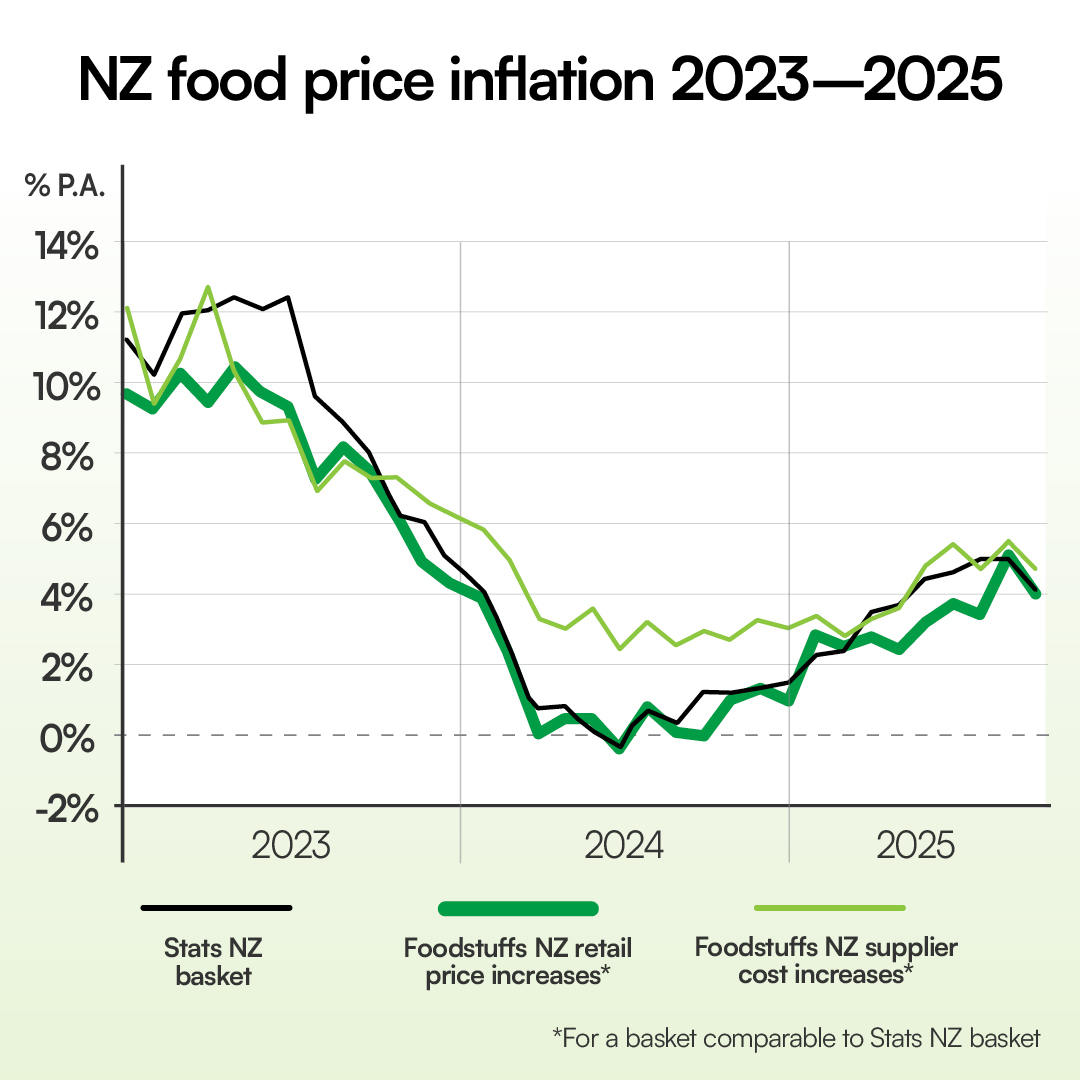Foodstuffs sees food price inflation ease, with seasonal produce offering spring value

1. Stats NZ records 4.1% annual food price inflation (FPI) in September, down from 5.0% in August
2. Foodstuffs sees retail prices rise 4.0% YOY for their comparable FPI basket of products
3. Olive oil prices continue to fall, with cucumber, capsicum and avocado also good value
4. Pams butter still sold by the Foodstuffs co-ops at a loss; shoppers shift to the country’s most popular brand for trusted value
The Foodstuffs grocery co-ops say they’re continuing to keep a close eye on inflation, with global demand still outstripping supply for some key items on the shopping list.
Stats NZ has reported an annual food price inflation (FPI) rate of 4.1% for September 2025, down from 5.0% in August 2025. The Foodstuffs grocery co-ops recorded an average year-on-year retail price increase of 4.0% for their comparable FPI basket of products. Foodstuffs’ supplier costs for goods in its FPI basket rose 4.7% in September, year on year.
Foodstuffs NZ Managing Director Chris Quin says the easing in headline inflation is welcome after several months of gradual increases, but underlying cost pressures remain across many categories.
“While global costs have started to moderate in some areas, what our co-ops pay for the grocery items New Zealand produces and exports remain elevated – especially dairy and red meat.
“Butter is still up 27% year-on-year in our basket, and we’re continuing to sell Pams butter at a loss as part of our commitment to make it as affordable and accessible as possible for shoppers,” says Quin.
He says there’s been a noticeable increase in shoppers turning to Foodstuffs’ private label products for better value.
“Our Pams range continues to grow in popularity, with unit sales up an average of 4.7% per year over the past two years. It’s a trusted and well-priced option, and right now that value really matters to a lot of households.”
Other products that saw big decreases year on year in September were cucumbers (down 29.3%), olive oil (down 20.6%), capsicums (down 17.3%), and avocados (down 11.1%).
Meanwhile, some of the steepest year-on-year price increases were seen in cabbage (up 81.9%), lettuce (+51.6%), and broccoli (+36.5%) – all still impacted by the colder winter which has reduced supply – as well as lamb leg roasts (+40.8%) and free range eggs (+38.1%).
Pork and chicken remain steady and continue to provide good value for families.
Quin says seasonal produce is providing more opportunities to save.
“Fortunately, spring is now here, and prices have started to ease after a slow start. We’ve had a bit of a cold snap which has slowed growth in things like asparagus and berries, but other produce has come back strongly. As they come into season, tomatoes and lettuce are coming down in price, and avocados are great value – all Kiwi favourites for this time of year as we head into summer.”
Quin notes that global falls in olive oil pricing are beginning to show up on shelves.
“It can take three months or more for changes in commodity prices for products like olive oil to be reflected in what shoppers see here – factoring in production, shipping, and stock already in the system. We’re starting to see those reductions now.”
Looking ahead, he says the outlook for spring produce is encouraging.
“We haven’t had any major weather events lately, but it’s a crucial time for tree crops like apricots and cherries. Over the next six weeks we’ll get a clearer picture of what the summer season will look like.
“We continue to work closely with local growers and producers to get seasonal produce onto shelves quickly and at good value.
“Our advice to customers is to plan your shopping list based on what’s in season.
“The local and global economic shocks of the past five years have changed customer behaviour. Our co-ops are competing hard to offer the best deals, by buying smart and seasonally, because New Zealanders are shopping around more than ever to make the grocery budget go further.”
Earlier this week, Infometrics reported a 2.3% increase in the Grocery Supplier Cost Index (GSCI) for September – the same result as in August. The GSCI monitors the cost of 60,000 goods stocked in the co-ops’ 500+ locally owned stores.
